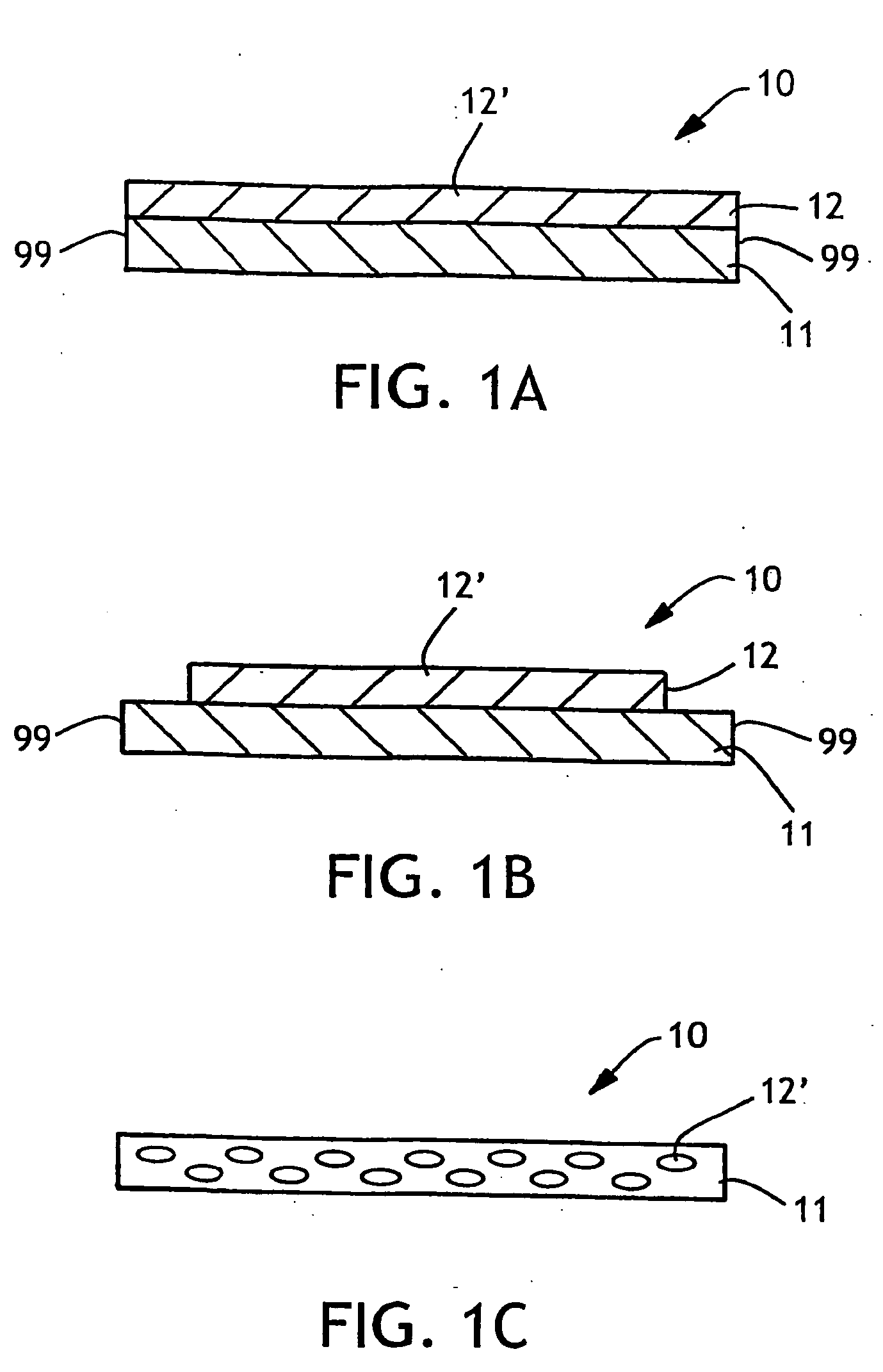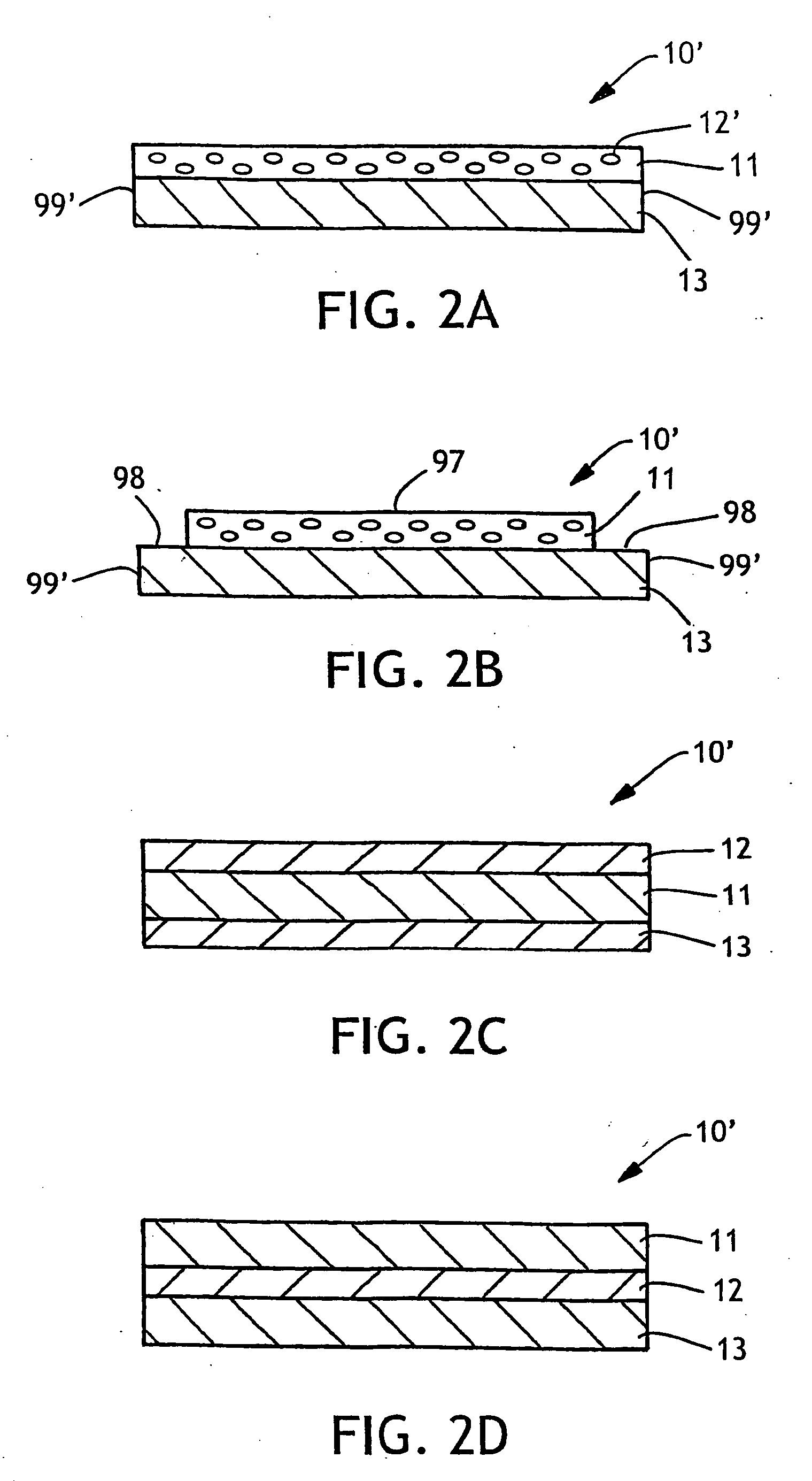Articles comprising transparent/translucent polymer composition
a polymer composition and transparent technology, applied in the direction of absorbent pads, tampons, bandages, etc., can solve the problems of not meeting the color of the wide variety of undergarments currently being manufactured by the clothing industry, preparing absorbent articles that cannot match or nearly match the color of the undergarments, and achieving the effect of improving performance, increasing comfort and confidence among users
- Summary
- Abstract
- Description
- Claims
- Application Information
AI Technical Summary
Benefits of technology
Problems solved by technology
Method used
Image
Examples
example 1
Flexible Superabsorbent Binder Polymer Composition
[0145] Initiator solutions were prepared as follows: (1) by dissolving 1.04 grams (g) of ascorbic acid in 21.3 g of water; (2) by dissolving 0.5 g of NAPS (sodium persulfate) in 2.9 g of water; and (3) by weighing out 1.93 g of 35% H2O2.
[0146] A crosslinker solution was prepared just prior to initiation. With rapid stirring, 1.4 mL of 3-(trimethoxysilyl)propyl methacrylate (MEMO) were added to 21.3 g of water producing a hazy solution.
[0147] A monomer solution was then prepared. While stirring at medium pace with a mechanical stirrer, approximately 626.8 g of water were added into a 1-gallon plastic bucket. To this water, 118.5 g of glacial acrylic acid were added. Then 52.8 g of 0% aqueous NaOH and 31.5 g of polyethylene glycol (PEG) with an average olecular weight of 200 were added and mixed. With continued mixing, this solution mixture was cooled to 20-22° C. while sparging with N2 gas. No cooling water or ice bath was used. Wh...
example 2
Absorbent Composite
[0152] A 21 gsm spunbond containing 1.8 denier polypropylene spunbond fibers containing about 1% by weight TiO2 and a wire weave bond pattern which was necked down 25%, and was treated with a surfactant solution mixture to provide wettability. The surfactant can be a 1:3 mixture of GLUCOPON 220 UP (available from Cognis Corporation, having a place of business in Cincinnati, Ohio, U.S.A) and AHCOVEL Base N-62 (available from Uniqema Inc., having a place of business in New Castle, Del., U.S.A.)., and the surfactant add-on level was 0.34% by weight. The spunbond was immersed in the binder solution to thoroughly saturate the fabric. Excess fluid was squeezed out, and the saturated spunbond was dried for 4 minutes at 105° C. in a MATHIS through-air-dryer oven. After drying, the coated fabric had about a 41 gsm dry add-on of the dried flexible superabsorbent binder polymer composition.
[0153] The reduction in the stiffness of the absorbent composite was determined util...
example 3
Absorbent Article
[0154] An absorbent composite was cut from the composite of Example 2 having a length of 101 mm long and 101 mm wide. The absorbent composite was then assembled as an absorbent layer of a pantiliner. The backing sheet of the pantiliner was formed from clear film (available from Pliant Corporation, having a place of business in Chippewa Falls, Wis., U.S.A.). The bodyside liner was an 18.5 gsm polypropylene spunbond with no TiO2 present in the polypropylene. The absorbent composite was placed between the film and the bodyside liner. The liner, film and composite were then joined together using a clear adhesive. The film and bodyside liner were then cut to a square shape, 140 mm by 140 mm. The resulting absorbent article had a central region containing the absorbent and a perimeter region surrounding the central region.
[0155] The light transmission of the central region of the absorbent article was tested in accordance with the Light Transmittance Test, and resulted ...
PUM
| Property | Measurement | Unit |
|---|---|---|
| light transmittance | aaaaa | aaaaa |
| light transmittance | aaaaa | aaaaa |
| light transmittance | aaaaa | aaaaa |
Abstract
Description
Claims
Application Information
 Login to View More
Login to View More - R&D
- Intellectual Property
- Life Sciences
- Materials
- Tech Scout
- Unparalleled Data Quality
- Higher Quality Content
- 60% Fewer Hallucinations
Browse by: Latest US Patents, China's latest patents, Technical Efficacy Thesaurus, Application Domain, Technology Topic, Popular Technical Reports.
© 2025 PatSnap. All rights reserved.Legal|Privacy policy|Modern Slavery Act Transparency Statement|Sitemap|About US| Contact US: help@patsnap.com



